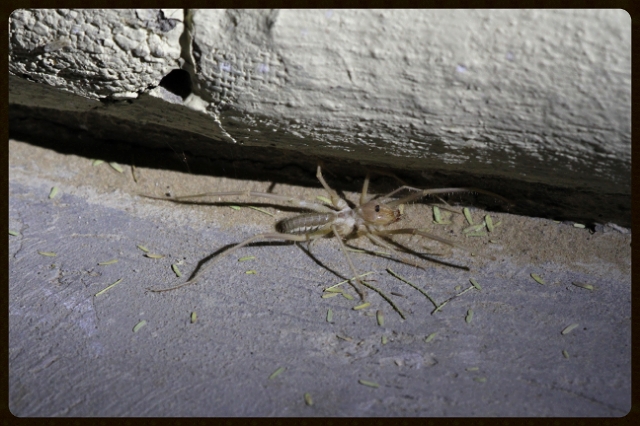Africa Wild Arachnid Book: Sun Spiders, Solifuges (Order Solifugae)
Upload your photo of a sun spider and add a description underneath. Please only do one species per post.
All entries will be edited and updated (additional photos and information will be added by moderators). New entries will be posted according to taxonomic order and the post date does not reflect the actual date of new posts.
AW Arachnid Book Sun Spiders Solifugae Photos & Descriptions
Moderator: Klipspringer
Re: AW Arachnid Book Sun Spiders Solifugae Photos & Descript
Index to Sun Spiders, Solifuges(Order Solifugae)
Families:
Ammotrechidae
Ceromidae
Daesiidae
Daesiid Sunspider https://africawild-forum.com/viewtopic. ... 61#p201161
Daesiid Sunspider https://africawild-forum.com/viewtopic. ... 12#p249612
Gylippidae
Hexisopodidae
Chelypus sp. Teddybear Solifuge, Mole Solifuge https://africawild-forum.com/viewtopic. ... 47#p487747
Melanoblossidae
Solpugidae
Zeria strepsiceros Diurnal Sun Spider https://africawild-forum.com/viewtopic. ... 29#p512929
Zeriassa sp. https://africawild-forum.com/viewtopic. ... 76#p248876
Unidentified Solifuge https://africawild-forum.com/viewtopic. ... 93#p202093
Families:
Ammotrechidae
Ceromidae
Daesiidae
Daesiid Sunspider https://africawild-forum.com/viewtopic. ... 61#p201161
Daesiid Sunspider https://africawild-forum.com/viewtopic. ... 12#p249612
Gylippidae
Hexisopodidae
Chelypus sp. Teddybear Solifuge, Mole Solifuge https://africawild-forum.com/viewtopic. ... 47#p487747
Melanoblossidae
Solpugidae
Zeria strepsiceros Diurnal Sun Spider https://africawild-forum.com/viewtopic. ... 29#p512929
Zeriassa sp. https://africawild-forum.com/viewtopic. ... 76#p248876
Unidentified Solifuge https://africawild-forum.com/viewtopic. ... 93#p202093
Re: AW Arachnid Book Sun Spiders Solifugae Photos & Descript
Sun Spiders, Red Romans, Wind Scorpions, Wind Spiders, Camel Spiders, Jerrymanders
Order: Solifugae
This group of arachnids has various common names most of which suggest that they are spiders, which they are not. The only obvious similarity they share with spiders is the fact that they have eight legs.
The name Solifugae derives from Latin, and means "those that flee from the sun". The term 'sun spider' applies to those species active during the day that tend to avoid the heat and dash from shadow to shadow - often of a person - giving the alarming impression that they are giving chase. The term 'red roman' probably originates from the Afrikaans term 'rooiman' (red man) due to the red-brown color of some species.
Distribution
There are 12 families, 140 genera and 1075 species of solifuges worldwide, with six families, 30 genera and 241 species recorded from southern Africa. Thus, 22% of the world solifuge species occur in southern Africa. The Northern Cape (81 species) and Namibia have the highest number of species. The Orange River does not restrict their distribution.
Morphology
Solifuges vary in size (10-70mm body length) and can have a leg span up to 160 mm.
The solifuges body is divided in two parts: a prosoma (carapace) and the opisthosoma (abdomen).
The prosoma is divided into three sections:
*the propeltidium (head) contains the chelicerae (jaws), eyes, pedipalps and first two pairs of legs.
The chelicera has a dorsal fixed finger and a movable ventral finger, both armed with cheliceral teeth for crushing prey. These teeth are one of the features used in identification. The rostrum (mouth) is situated between the pedipalpal coxa. Solifuges have two simple eyes on a raised ocular tubercle on the anterior edge of the propeltidium but it is not yet known if it is only to detect light or darkness or has a visual capability. There is a belief that the vision may be acute and even used to watch for aerial predators. Rudimentary lateral eyes are usually absent.
*the mesopeltidium contains the third pair of legs.
*the metapelptidium contains the forth pair of legs.
Solifuges appear to have 10 legs but in fact, the first pair of appendages is the pedipalps that are very strong and are used for various functions such as drinking, catching, feeding, mating and climbing. The most unusual feature is the unique suctorial organs on the tips of their pedipalps. Some solifuges are known to be able to use these organs to climb vertical surfaces, but this does not appear to be required in the wild. All the legs have a sub divided femur (prefemur and postfemur) while the tarsus may, or may not, be segmented with tarsal claws, The first pair of legs is thin and short and used as tactile organs (feelers) and not for locomotion and may or may not have tarsal claws. Solifuges, together with pseudoscorpions, lack a patella (a leg segment found in spiders, scorpions, and other arachnids). The fourth pair of legs is the longest and carries the malleoli, unique racquet organs, on the coxa and subdivided trochanter and probably have chemosensory properties. Most species have 5 pairs of malleoli while juveniles and some species only have 2-3 pairs.
The opisthosoma (abdomen) consists of eleven somites (segments) and it is considered that the metapeltidium is regarded as the first of the segments or alternatively covers the first. The somites are covered dorsally by a tergite and ventrally by a sternite. The abdomen is soft and expandable that enables the animal to eat large amounts of food. Solifuges, similar to pseudoscorpions and harvestmen, lack book lungs, replaced ventrally by two tracheal spiracles on the prosoma and two or three on the opisthosoma. The genitalia are situated on the 2nd sternite with the anal tubercle on the last somite.
Biology
They live in scraped out sand retreats, often under rocks and logs or burrows up to 230mm deep. The chelicerae are used for digging while the body bulldozes the sand out or alternately the hind legs are used to clear the sand. Solifuges are mostly nocturnal but there are diurnal species that are usually more brightly colored with light and dark bands running the length of the body, while the nocturnal species are a yellowish brown and often larger.
Solifuges are solitary, have no venom glands and are not a threat to people although they are very aggressive and fast moving and can inflict a painful bite.
Food
Solifuges prey on various insects, spiders, scorpions, small reptiles, dead birds and even each other. Some species are exclusively termite predators. Some solifuges sit in the shade and ambush their prey. Others run their prey down and once they catch it they eat while the prey is still alive with vigorous ripping and cutting actions of the powerful jaws. Video footage has revealed that solifuges catch their prey with their forward stretched pedipalps using the distal suctorial organs to fasten onto the prey. The suctorial organ is usually not visible as it is encased in a dorsal and ventral cuticular lip. Once the prey has been caught and transferred to the chelicerae the sucktorial gland is enclosed. Haemolymph pressure is used to open and protrude the suctorial organ. This superficially resembles a shortened chameleon tongue. The adhesive properties appear to be van der Waals force.
Predators
Several raptors, owls and small mammals consume solifuges in their diets including the Bat-eared fox, Small-spotted genet, Cape fox, African civet and Black-backed jackal.
Reproduction
Male solifuges have aerial-like flagella on the chelicerae (like backward swept aerials), uniquely shaped for each species, that probably play some part in mating. Males may use these flagella to insert the spermatophore into the females’ genital opening. The male seeks out a female, using its suctorial organ he rips the female from her retreat, males use their pedipalps to coerce the female into a frozen state, and sometimes massages her abdomen with his chelicerae while he deposits a spermatophore in the female's genital opening. About 20 to 200 eggs are produced and hatch within about four weeks. The first stage of development, once hatched, is a larva and once the casing has cracked open the larva moults into a solifuge nymph. Solifuges live for about a year and pass through 9-10 instars before maturity.
http://www.biodiversityexplorer.info/ar ... /index.htm
https://www.researchgate.net/publicatio ... 9/download
https://koedoe.co.za/index.php/koedoe/a ... ad/114/116
https://www.researchgate.net/publicatio ... _Solifugae
Order: Solifugae
This group of arachnids has various common names most of which suggest that they are spiders, which they are not. The only obvious similarity they share with spiders is the fact that they have eight legs.
The name Solifugae derives from Latin, and means "those that flee from the sun". The term 'sun spider' applies to those species active during the day that tend to avoid the heat and dash from shadow to shadow - often of a person - giving the alarming impression that they are giving chase. The term 'red roman' probably originates from the Afrikaans term 'rooiman' (red man) due to the red-brown color of some species.
Distribution
There are 12 families, 140 genera and 1075 species of solifuges worldwide, with six families, 30 genera and 241 species recorded from southern Africa. Thus, 22% of the world solifuge species occur in southern Africa. The Northern Cape (81 species) and Namibia have the highest number of species. The Orange River does not restrict their distribution.
Morphology
Solifuges vary in size (10-70mm body length) and can have a leg span up to 160 mm.
The solifuges body is divided in two parts: a prosoma (carapace) and the opisthosoma (abdomen).
The prosoma is divided into three sections:
*the propeltidium (head) contains the chelicerae (jaws), eyes, pedipalps and first two pairs of legs.
The chelicera has a dorsal fixed finger and a movable ventral finger, both armed with cheliceral teeth for crushing prey. These teeth are one of the features used in identification. The rostrum (mouth) is situated between the pedipalpal coxa. Solifuges have two simple eyes on a raised ocular tubercle on the anterior edge of the propeltidium but it is not yet known if it is only to detect light or darkness or has a visual capability. There is a belief that the vision may be acute and even used to watch for aerial predators. Rudimentary lateral eyes are usually absent.
*the mesopeltidium contains the third pair of legs.
*the metapelptidium contains the forth pair of legs.
Solifuges appear to have 10 legs but in fact, the first pair of appendages is the pedipalps that are very strong and are used for various functions such as drinking, catching, feeding, mating and climbing. The most unusual feature is the unique suctorial organs on the tips of their pedipalps. Some solifuges are known to be able to use these organs to climb vertical surfaces, but this does not appear to be required in the wild. All the legs have a sub divided femur (prefemur and postfemur) while the tarsus may, or may not, be segmented with tarsal claws, The first pair of legs is thin and short and used as tactile organs (feelers) and not for locomotion and may or may not have tarsal claws. Solifuges, together with pseudoscorpions, lack a patella (a leg segment found in spiders, scorpions, and other arachnids). The fourth pair of legs is the longest and carries the malleoli, unique racquet organs, on the coxa and subdivided trochanter and probably have chemosensory properties. Most species have 5 pairs of malleoli while juveniles and some species only have 2-3 pairs.
The opisthosoma (abdomen) consists of eleven somites (segments) and it is considered that the metapeltidium is regarded as the first of the segments or alternatively covers the first. The somites are covered dorsally by a tergite and ventrally by a sternite. The abdomen is soft and expandable that enables the animal to eat large amounts of food. Solifuges, similar to pseudoscorpions and harvestmen, lack book lungs, replaced ventrally by two tracheal spiracles on the prosoma and two or three on the opisthosoma. The genitalia are situated on the 2nd sternite with the anal tubercle on the last somite.
Biology
They live in scraped out sand retreats, often under rocks and logs or burrows up to 230mm deep. The chelicerae are used for digging while the body bulldozes the sand out or alternately the hind legs are used to clear the sand. Solifuges are mostly nocturnal but there are diurnal species that are usually more brightly colored with light and dark bands running the length of the body, while the nocturnal species are a yellowish brown and often larger.
Solifuges are solitary, have no venom glands and are not a threat to people although they are very aggressive and fast moving and can inflict a painful bite.
Food
Solifuges prey on various insects, spiders, scorpions, small reptiles, dead birds and even each other. Some species are exclusively termite predators. Some solifuges sit in the shade and ambush their prey. Others run their prey down and once they catch it they eat while the prey is still alive with vigorous ripping and cutting actions of the powerful jaws. Video footage has revealed that solifuges catch their prey with their forward stretched pedipalps using the distal suctorial organs to fasten onto the prey. The suctorial organ is usually not visible as it is encased in a dorsal and ventral cuticular lip. Once the prey has been caught and transferred to the chelicerae the sucktorial gland is enclosed. Haemolymph pressure is used to open and protrude the suctorial organ. This superficially resembles a shortened chameleon tongue. The adhesive properties appear to be van der Waals force.
Predators
Several raptors, owls and small mammals consume solifuges in their diets including the Bat-eared fox, Small-spotted genet, Cape fox, African civet and Black-backed jackal.
Reproduction
Male solifuges have aerial-like flagella on the chelicerae (like backward swept aerials), uniquely shaped for each species, that probably play some part in mating. Males may use these flagella to insert the spermatophore into the females’ genital opening. The male seeks out a female, using its suctorial organ he rips the female from her retreat, males use their pedipalps to coerce the female into a frozen state, and sometimes massages her abdomen with his chelicerae while he deposits a spermatophore in the female's genital opening. About 20 to 200 eggs are produced and hatch within about four weeks. The first stage of development, once hatched, is a larva and once the casing has cracked open the larva moults into a solifuge nymph. Solifuges live for about a year and pass through 9-10 instars before maturity.
http://www.biodiversityexplorer.info/ar ... /index.htm
https://www.researchgate.net/publicatio ... 9/download
https://koedoe.co.za/index.php/koedoe/a ... ad/114/116
https://www.researchgate.net/publicatio ... _Solifugae
Last edited by ExFmem on Tue Jan 27, 2015 6:23 pm, edited 1 time in total.
Re: Index to Africa Wild Insect & Invertebratae Books
Solifuge, Sun Spider
Order: Solifugae
Family Daesiidae
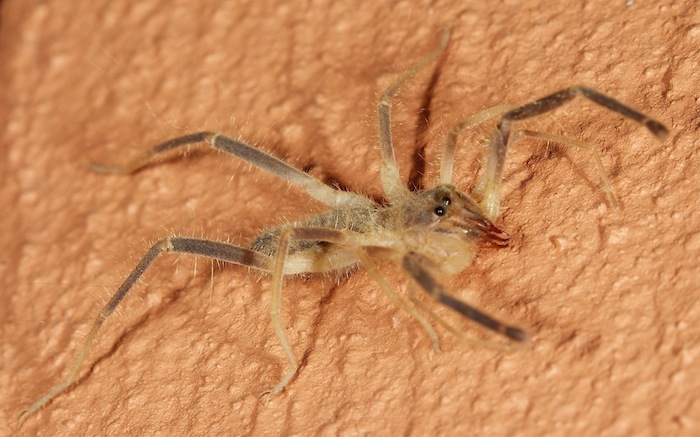
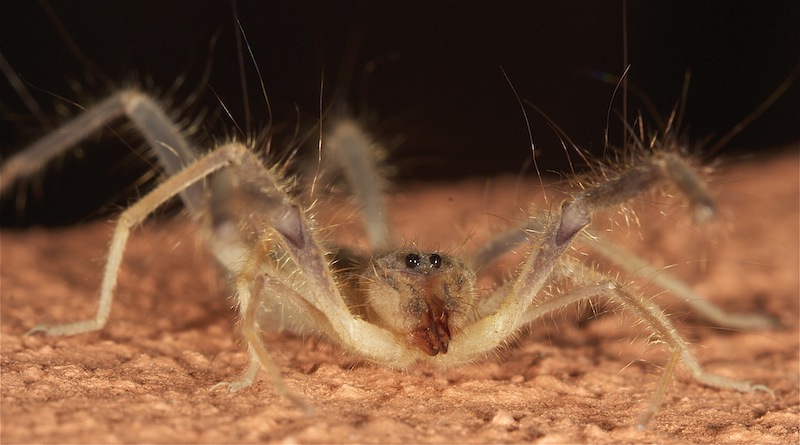
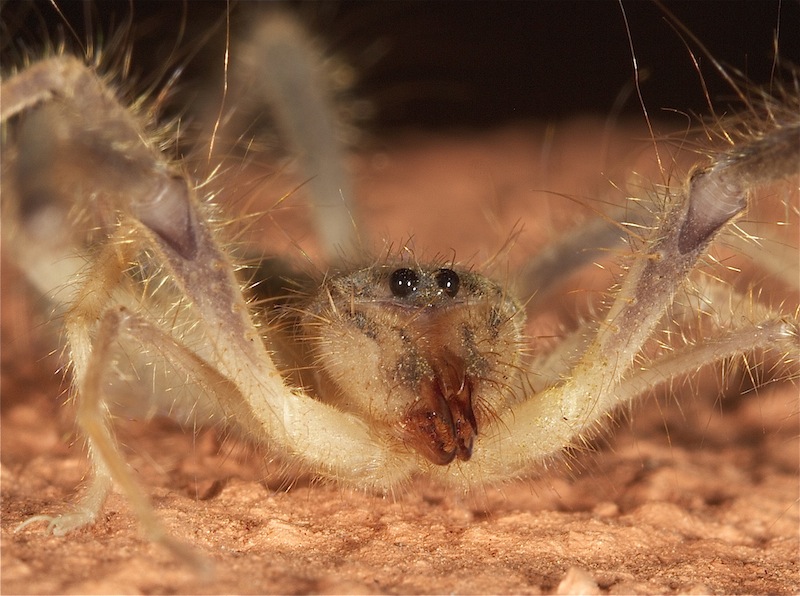
Nossob, KTP
Solifugae recorded from Kgalagadi Transfrontier Park:
Biton (Biton) longisetosus Lawrence, 1972*
Biton (Biton) schultzei (Kraepelin, 1908)
Biton (Biton) tenuifalcis Lawrence, 1962
Blossia pallideflava (Lawrence, 1972)*
Blossia rosea (Lawrence, 1935a)*
Chelypus barberi Purcell, 1902
Chelypus hirsti Hewitt, 1915
Chelypus lennoxae Hewitt, 1912
Order: Solifugae
Family Daesiidae



Nossob, KTP
Solifugae recorded from Kgalagadi Transfrontier Park:
Biton (Biton) longisetosus Lawrence, 1972*
Biton (Biton) schultzei (Kraepelin, 1908)
Biton (Biton) tenuifalcis Lawrence, 1962
Blossia pallideflava (Lawrence, 1972)*
Blossia rosea (Lawrence, 1935a)*
Chelypus barberi Purcell, 1902
Chelypus hirsti Hewitt, 1915
Chelypus lennoxae Hewitt, 1912
Re: AW Arachnid Book Sun Spiders Solifugae Photos & Descript
10.03. - 24.03.2015 From Berg to bush
19.11. - 01.12.2015 KTP
19.11. - 01.12.2015 KTP
AW Arachnid Book Sun Spiders Solifugae Photos & Descript
Solifuge, Sun Spider Zeriassa sp.
Order Solifugae. Family Solpugidae
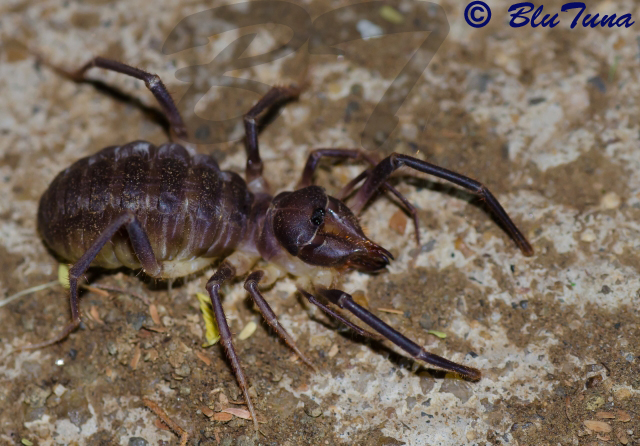 © BluTuna
© BluTuna
Balule, Kruger National Park
Zeriassa spp have have two distinct, forward-projecting bristles between the eyes.
Zeriassa spp recorded from KNP:
Zeriassa furcicornis
Zeriassa purcelli
Zeriassa transvaalensis (Chelicerae yellow)
Zeriassa tuxeni
Order Solifugae. Family Solpugidae
 © BluTuna
© BluTunaBalule, Kruger National Park
Zeriassa spp have have two distinct, forward-projecting bristles between the eyes.
Zeriassa spp recorded from KNP:
Zeriassa furcicornis
Zeriassa purcelli
Zeriassa transvaalensis (Chelicerae yellow)
Zeriassa tuxeni
Re: AW Arachnid Book Sun Spiders Solifugae Photos & Descript
Solifuge, Sun Spider
Order: Solifugae
Family Daesiidae
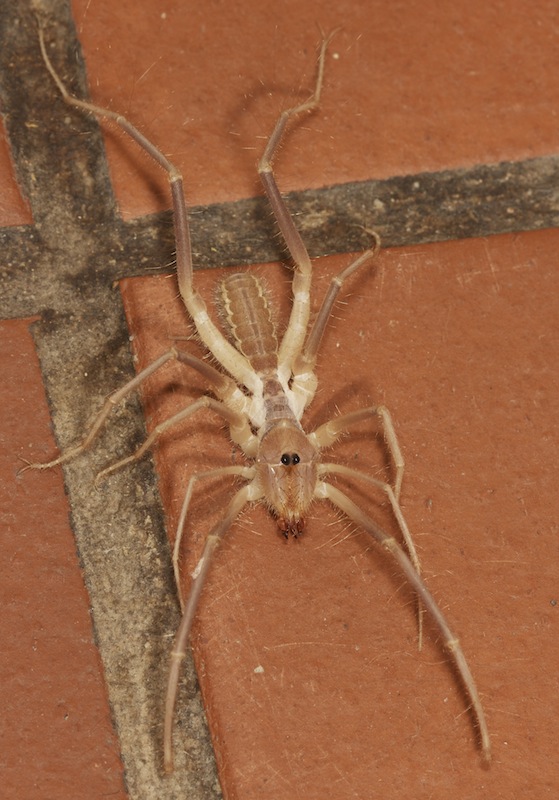
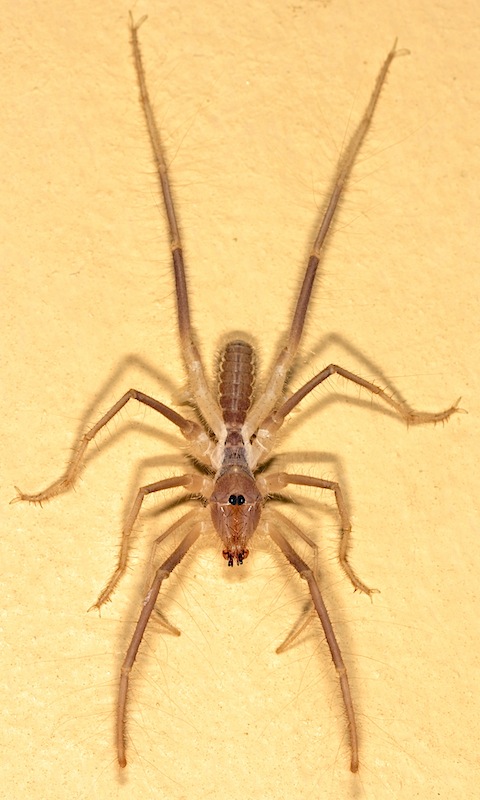
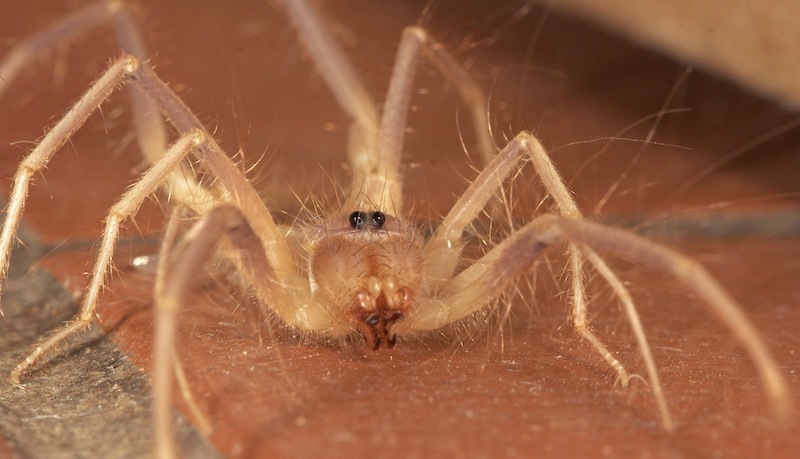
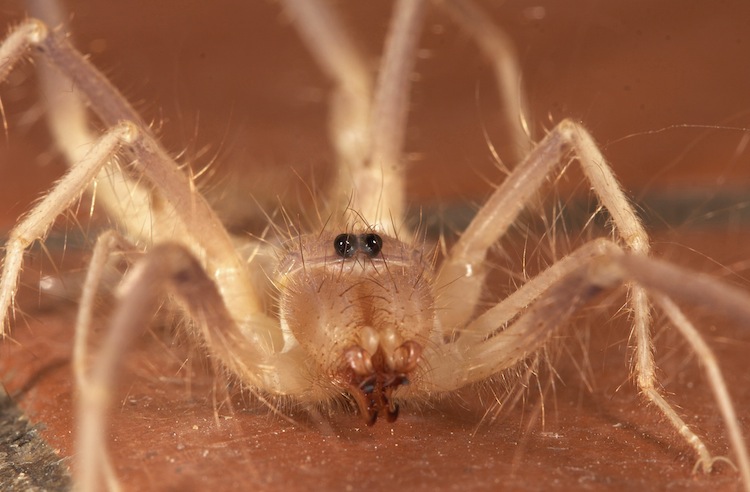
Kieliekrankie, KTP
Order: Solifugae
Family Daesiidae




Kieliekrankie, KTP
-
Klipspringer
- Global Moderator
- Posts: 5858
- Joined: Sat Sep 14, 2013 12:34 pm
- Country: Germany
- Contact:
Re: AW Arachnid Book Sun Spiders Solifugae Photos & Descript
Teddybear Solifuge, Mole Solifuge Chelypus sp.
Order: Solifugae. Family: Hexisopodidae
Members of the family Hexisopodidae occur in southern Africa. The 25 known species are distributed among two genera: Chelypus (9 species) and Hexisopus (15 species). They are readily distinguished from other members of the order Solifugae by the lack of claws on the fourth pair of legs. Leg IV without tarsal claws; legs strongly fossorial.
Chelypus is distinguished from Hexisopus by the presence of well-developed spines on the pedipalps.
There are 3 species recorded from KTP: Chelypus barberi, Chelypus hirsti, Chelypus lennoxae.
Teddybear Solifuge are fossorials and can dig into soil with an amazing speed. They spend a large part of their existence underground, and their 2nd, 3rd and particularly 4th pair of legs are shortened and robust, and equipped with rake-like spines for digging.
Their 4th pair of legs possess 3 in the Hexisopodidae 'malleoli' or 'racquet organs' (fan-shaped chemoreceptors). Their function is not entirely clear, but they seem to be extremely sensitive organs of smell, and play a role in both detection of prey and finding a mating partner.
Solifugids look as if they had five pairs of legs, but the first pair, the pedipalps, is in fact an element of the mouthparts. At the tip of the pedipals solifugids have unique suctorial organs that, like the suction cups on the arms of an octopus, help them catch and hold their prey. Their chelicerae (“jaws”) are so huge and muscular that it is easy to confuse them with the entire head of the animal.
.
Kgalagadi Transfrontier Park, South Africa © Mel
Links:
http://www.biodiversityexplorer.info/ar ... odidae.htm
https://www.researchgate.net/publicatio ... 9/download
https://www.researchgate.net/publicatio ... 8/download
Order: Solifugae. Family: Hexisopodidae
Members of the family Hexisopodidae occur in southern Africa. The 25 known species are distributed among two genera: Chelypus (9 species) and Hexisopus (15 species). They are readily distinguished from other members of the order Solifugae by the lack of claws on the fourth pair of legs. Leg IV without tarsal claws; legs strongly fossorial.
Chelypus is distinguished from Hexisopus by the presence of well-developed spines on the pedipalps.
There are 3 species recorded from KTP: Chelypus barberi, Chelypus hirsti, Chelypus lennoxae.
Teddybear Solifuge are fossorials and can dig into soil with an amazing speed. They spend a large part of their existence underground, and their 2nd, 3rd and particularly 4th pair of legs are shortened and robust, and equipped with rake-like spines for digging.
Their 4th pair of legs possess 3 in the Hexisopodidae 'malleoli' or 'racquet organs' (fan-shaped chemoreceptors). Their function is not entirely clear, but they seem to be extremely sensitive organs of smell, and play a role in both detection of prey and finding a mating partner.
Solifugids look as if they had five pairs of legs, but the first pair, the pedipalps, is in fact an element of the mouthparts. At the tip of the pedipals solifugids have unique suctorial organs that, like the suction cups on the arms of an octopus, help them catch and hold their prey. Their chelicerae (“jaws”) are so huge and muscular that it is easy to confuse them with the entire head of the animal.
.
Kgalagadi Transfrontier Park, South Africa © Mel
Links:
http://www.biodiversityexplorer.info/ar ... odidae.htm
https://www.researchgate.net/publicatio ... 9/download
https://www.researchgate.net/publicatio ... 8/download
-
Klipspringer
- Global Moderator
- Posts: 5858
- Joined: Sat Sep 14, 2013 12:34 pm
- Country: Germany
- Contact:
Re: AW Arachnid Book Sun Spiders Solifugae
Family Characters for Solifugae in Southern Africa
Solpugidae Common Romans
All species in the sub-region belong to the subfamily Solpuginae.
Tarsal segments numbering 1,4,4,7.
Flagellum short to long, whip-like but often thickened or branched.
Most recogniseable genera:
Solpugema (legs with minute accessory spines, giving them a much more finely-furred look right to their claws). Some Solpugema (of the 'hostilis' group) are distinctive having bright red hind legs.
Zeriassa (small, more or less hairless, often purple, with two long, forward-pointing bristles between the eyes)
Solpugiba (pedipalps very short, body often with longitudinal stripes).
Zeria and Solpuga are very common.
Daesiidae
Flagellum membranous, claws thin, almost hairlike.
Tarsal segments numbering either 1,2,2,4 (Biton only)
1,2,2,3 (Eberlanzia and Namibesia, both are small desert species).
1,1,1,2 (Blossia )only.
1,1,1,1 - Hemiblossia, Hemiblossiola and Parablossia.
Some may have a small indentation in the middle of the hind tarsus, which makes them appear to have two segments, but segments are actually fused.
Ceromidae Whip Romans
Endemic to Southern Africa.
Flagellum thin, dark, whip-like; often extending behind head.
Tarsal segments 1,2,2,2.
Body rounded, legs quite short; most specimens with three lines of dark blotches along abdomen belong to genus Ceroma (but at least one species of Ceromella in the Western Cape also shows this).
Hexisopodidae Mole Romans or Teddybear Romans
Tarsal segments 1,2,2,2, but highly modified; legs all short, spade-like, particularly in the male.
Flagellum short, inconspicuous, but essentially whip-like.
Two genera only; Chelypus with strong spines on pedipalps, and often toothless chelicerae, Hexisopus without strong spines on pedipalps, chelicerae usually toothed in both sexes.
All are very hairy, and can essentially look like scuttling balls of fur, teddybear-like.
Melanoblossidae
Small to very small, mostly western (at least one as far east as Kimberley), often dark.
Tarsal segments numbering 1,1,1,2 (Melanoblossiinae) or 1,1,1,1 (Lawrencega only).
Flagellum, when present, short, concealed between chelicerae; but distinctly feather-like and surrounded by similar, feather-like spines.
Gylippidae
Confined to western parts of Southern Africa, apparently quite rare.
Tarsal segments numbering 1-1-1-1.
Solpugidae Common Romans
All species in the sub-region belong to the subfamily Solpuginae.
Tarsal segments numbering 1,4,4,7.
Flagellum short to long, whip-like but often thickened or branched.
Most recogniseable genera:
Solpugema (legs with minute accessory spines, giving them a much more finely-furred look right to their claws). Some Solpugema (of the 'hostilis' group) are distinctive having bright red hind legs.
Zeriassa (small, more or less hairless, often purple, with two long, forward-pointing bristles between the eyes)
Solpugiba (pedipalps very short, body often with longitudinal stripes).
Zeria and Solpuga are very common.
Daesiidae
Flagellum membranous, claws thin, almost hairlike.
Tarsal segments numbering either 1,2,2,4 (Biton only)
1,2,2,3 (Eberlanzia and Namibesia, both are small desert species).
1,1,1,2 (Blossia )only.
1,1,1,1 - Hemiblossia, Hemiblossiola and Parablossia.
Some may have a small indentation in the middle of the hind tarsus, which makes them appear to have two segments, but segments are actually fused.
Ceromidae Whip Romans
Endemic to Southern Africa.
Flagellum thin, dark, whip-like; often extending behind head.
Tarsal segments 1,2,2,2.
Body rounded, legs quite short; most specimens with three lines of dark blotches along abdomen belong to genus Ceroma (but at least one species of Ceromella in the Western Cape also shows this).
Hexisopodidae Mole Romans or Teddybear Romans
Tarsal segments 1,2,2,2, but highly modified; legs all short, spade-like, particularly in the male.
Flagellum short, inconspicuous, but essentially whip-like.
Two genera only; Chelypus with strong spines on pedipalps, and often toothless chelicerae, Hexisopus without strong spines on pedipalps, chelicerae usually toothed in both sexes.
All are very hairy, and can essentially look like scuttling balls of fur, teddybear-like.
Melanoblossidae
Small to very small, mostly western (at least one as far east as Kimberley), often dark.
Tarsal segments numbering 1,1,1,2 (Melanoblossiinae) or 1,1,1,1 (Lawrencega only).
Flagellum, when present, short, concealed between chelicerae; but distinctly feather-like and surrounded by similar, feather-like spines.
Gylippidae
Confined to western parts of Southern Africa, apparently quite rare.
Tarsal segments numbering 1-1-1-1.
-
Klipspringer
- Global Moderator
- Posts: 5858
- Joined: Sat Sep 14, 2013 12:34 pm
- Country: Germany
- Contact:
Re: AW Arachnid Book Sun Spiders Solifugae Photos & Descript
Diurnal Sun Spider Zeria strepsiceros
Order Solifugae. Family Solpugidae

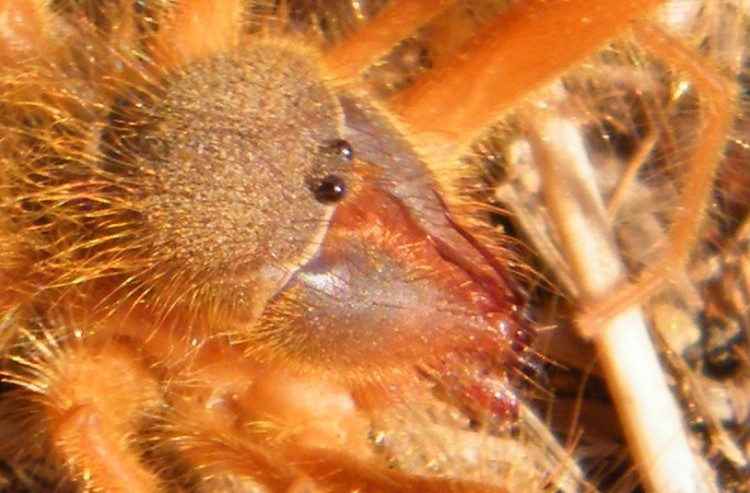
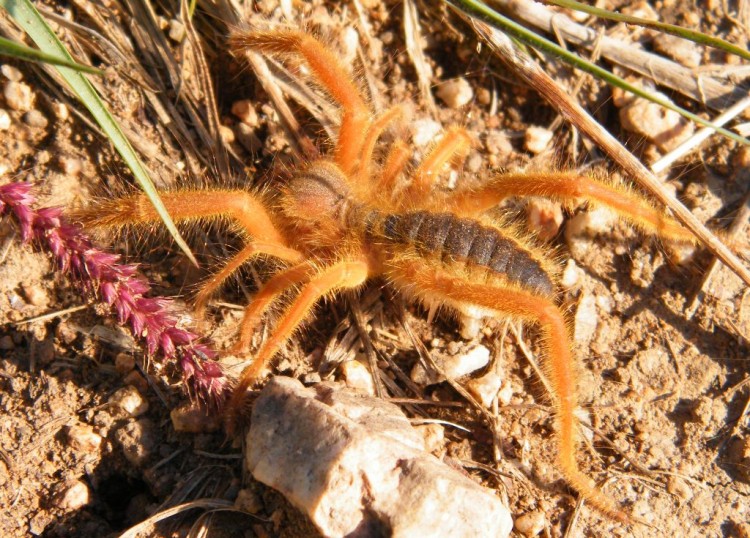

Adult male, Crocodile Gorge Conservancy, Mpumalanga © Richprins
There are three sister species (Zeria serraticornis: distribution includes Limpopo, Mpumalanga, Zimbabwe, Mozambique, DRC and Ethiopia; Zeria spiralicornis: recorded from Limpopo, Mpumalanga, including Kruger National Park and Zimbabwe; Zeria strepsiceros: recorded from Limpopo, Mpumalanga and Mozambique) and quite some confusion in the literature, the entire family Solipugidae is in need of revision.
More recently, the specimen from South Africa may be considered a distinct subspecies: Zeria strepsiceros nocturna:
Type locality: Orpen Camp, Kruger National Park. Various records from Kruger National Park (Orpen Camp, Mtsawu Drift, Doispanne road, Sitlabe Dam, Sabi Poort, Krokodil Bridge)
https://www.researchgate.net/publicatio ... _Solifugae
All of the 3, 4 or 5 sister species have records from Barberton and the lowveld or KNP - what a taxonomic mess
This is available from the relevant papers:
Hewitt: A short survey of the Solifugae of South Africa, Annals of the Transvaal Museum, Volume 7, 1919 https://www.biodiversitylibrary.org/page/50361481
Roewer: KLASSEN UND ORDNUNGEN DES TIERREICHS Fünfter Band 4. Abteilung 4. Buch. SOLIFUGA, PALPIGRADA. 1933
Here a museum specimen:
Order Solifugae. Family Solpugidae
Adult male, Crocodile Gorge Conservancy, Mpumalanga © Richprins
There are three sister species (Zeria serraticornis: distribution includes Limpopo, Mpumalanga, Zimbabwe, Mozambique, DRC and Ethiopia; Zeria spiralicornis: recorded from Limpopo, Mpumalanga, including Kruger National Park and Zimbabwe; Zeria strepsiceros: recorded from Limpopo, Mpumalanga and Mozambique) and quite some confusion in the literature, the entire family Solipugidae is in need of revision.
More recently, the specimen from South Africa may be considered a distinct subspecies: Zeria strepsiceros nocturna:
Type locality: Orpen Camp, Kruger National Park. Various records from Kruger National Park (Orpen Camp, Mtsawu Drift, Doispanne road, Sitlabe Dam, Sabi Poort, Krokodil Bridge)
https://www.researchgate.net/publicatio ... _Solifugae
All of the 3, 4 or 5 sister species have records from Barberton and the lowveld or KNP - what a taxonomic mess
This is available from the relevant papers:
Hewitt: A short survey of the Solifugae of South Africa, Annals of the Transvaal Museum, Volume 7, 1919 https://www.biodiversitylibrary.org/page/50361481
Roewer: KLASSEN UND ORDNUNGEN DES TIERREICHS Fünfter Band 4. Abteilung 4. Buch. SOLIFUGA, PALPIGRADA. 1933
S. spiralicornis
Schaftende des Flagellum doppelt gebogen und mit der äußersten Spitze stark lateralwärts gekrümmt, Vorderbogen des Flagellum über dem
1. Vorderzahn vom unbeweglichen Finger aufsteigend; Gebiß und Flagellum (Abb. 294, d); Färbung rostgelb, Pleura jederseits der gelblichen
Tergite schmal geschwärzt, Malleoli weiß; Körperlänge 32-44 mm; Transvaal
S. serraticornis
Schaftende des Flagellum einfach gekrümmt und mit seiner äußersten Spitze nicht wesentlich lateralwärts gebogen (Abb.294, c1); Vorderbogen
des Flagellum über dem 2. Vorderzahn des unbeweglichen Fingers gelegen; Gebiß und Flagellum (Abb. 294, c); Färbung rostgelb, Tergite des Opisthosoma dunkelbraun wie die Pleura neben ihnen; Malleoli gelbweiß; Körperlänge bis 55 mm; Rhodesia, Portug. Ost-Afrika
S. strepsiceros
Schaftende des Flagellum mit Sägezähnchen besetzt. Schaft des Flagellum in Dorsalansicht schraubig gewunden (Abb.294, e1); beweglicher Finger medial mit 10-12 verdickten Borsten; Gebiß und Flagellum (Abb. 294, e); Färbung wie S. serraticornis; Körperlänge 23 mm; Delagoa-Bai, Transvaal.
Here a museum specimen:



